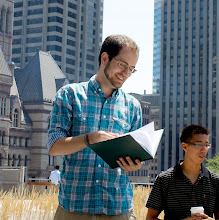Sarnia can still become a 'natural city'
- July 17, 2006, The Observer
Sarnia: the natural city?
On my walk home from work today, I passed a green lawn. In the centre was a small sign, warning humans of pesticide use. Didn’t look very inviting. I noticed grass, and nothing much else. It did not look like anything I have ever seen in nature, in a forest, meadow or prairie. As I kept walking, I saw that this property was separated from the next by a completely different way of thinking.
This next piece of earth was covered in tall grasses, wild lupine, chives and wild strawberry. It looked good: interesting, colourful and diverse. The lupine provides for the Karner Blue butterfly, the strawberries will soon provide for the people. A Staghorn Sumac tree in the garden fits nicely below telephone lines and provides habitat area for some birds. No chemicals needed. Much less maintenance and money would have been spent.
Of course, a strong grass turf is still possible without the use of toxic chemicals, as has been stated recently by The Observer. But many local groups advocate that property owners go a step further, and naturalize.
Many members of Lambton Wildlife have been managing their properties with native plants, gardens and trees for years. A native plant species is one that is found naturally in the Carolinian forest region of which Lambton County is a part. Foreign species known as “aliens” occasionally become invasive, and replace the plants that belong. Sometimes, they are planted instead of native species, and place local ecology off-balance.
Members of Energy Exchange, the downtown studio of art and ecology, with other volunteers, have planted and keep a native garden at Christina and Davis Streets. It acts as a demonstration garden to show which species exist in the area and can be planted at home. College Park on College St. has a garden by the Sarnia Urban Wildlife Committee and is another good spot to see native plants in action. After a couple years, the plants in these gardens have established themselves well. They require less water than other garden plants.
Shawn McKnight of Energy Exchange (ee) is one of the foremost environmental thinkers in the region. He sees the city taking on a new image, a positive one of naturalization. For residents, schools, municipalities, small businesses and industry, it means working with nature, beginning by planting species on their properties that belong there. The City, needing to save money with parks, could make the switch to planting fields or gardens of native species, rather than spending extra money on annuals and turf maintenance.
If you’re going for a small forest ecosystem on your property, you can start by covering a small section of your lawn with newspaper to kill the grass and weeds, then spread woodchips and plant a White Oak, Basswood or Tulip Tree. If you want a prairie garden, start with plants like Grey-headed Coneflower, Wild Lupine and Sullivant's Milkweed. These are just examples of species; there is a wealth of information online.
We can’t forget about solving the problems we face in the area, but at the same time we can make change that will regenerate the essence of our city and villages. Naturalization is a way to simultaneously ‘brand’ ourselves positively, and create a healthier community.
Stop by the studio for free plant lists, and ideas on how to get started on naturalizing your lawn.
------------------------
Darcy Higgins is a native of Sarnia who is currently completing a degree in Environmental Studies. He can be reached by e-mail at darcyhiggins@gmail.com


0 Comments:
Post a Comment
<< Home